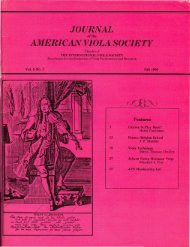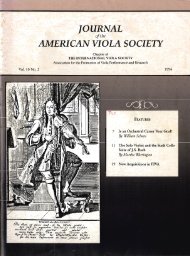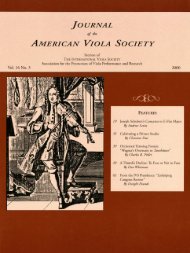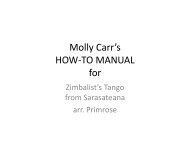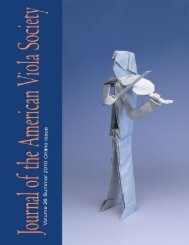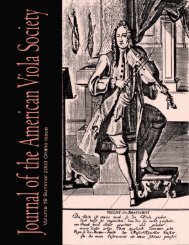Summer 2013 - The American Viola Society
Summer 2013 - The American Viola Society
Summer 2013 - The American Viola Society
Create successful ePaper yourself
Turn your PDF publications into a flip-book with our unique Google optimized e-Paper software.
y Jorge Barrón Corvera<br />
Manuel M. Ponce’s Trio for<br />
Ponce (1882–1948) is internationally recognized<br />
as one of Mexico’s foremost composers and has<br />
been widely acknowledged as a pioneer of<br />
musical nationalism in his country. His prolific<br />
catalogue contains more than three hundred<br />
compositions. A man of vast culture, he wrote<br />
over two hundred articles about musical topics<br />
and was the founding editor of three influential<br />
music journals: Revista Musical de México<br />
(Mexico, 1919–20), Gaceta Musical (Paris,<br />
1928–29), and Cultura Musical (Mexico, 1936–<br />
37). Polyglot and multifaceted, he undertook a<br />
career with an array of occupations including<br />
teacher, music critic, editor, researcher, lecturer,<br />
administrator, conductor, pianist, and composer.<br />
He studied music in the cities of Mexico (1901),<br />
Bologna (1905), Berlin (1906), and in Paris<br />
Violin, <strong>Viola</strong>, and Cello<br />
VOLUME 29 SUMMER <strong>2013</strong> ONLINE ISSUE<br />
(1925–32) at the École Normale de Musique<br />
with Paul Dukas. His eclectic musical style<br />
ranges through Baroque, Classical, Romantic,<br />
Impressionistic, Neoclassic, and Neoromantic.<br />
In addition, many of his works are influenced by<br />
the music of Cuba, Spain, and especially by that<br />
of Mexico.<br />
Ponce was first known as the composer of<br />
Estrellita (Little Star, 1912), an enchanting song<br />
that quickly captivated audiences around the<br />
world. Beginning in 1923, Ponce wrote for the<br />
William Primrose Portrait celebrated Unveiling Spanish guitarist Andrés Segovia a<br />
large body of guitar compositions, crowned by<br />
his Concierto del Sur (1941). His many pieces<br />
for guitar constitute one of the single most<br />
important contributions to the literature of that<br />
instrument. On a larger scale, a number of his<br />
orchestral works became well-known during his<br />
lifetime. Interest in exploring his complete<br />
Manuel M. Ponce<br />
catalogue is growing among musicians and<br />
researchers.<br />
To Carlos Prieto Jacqué<br />
26<br />
Composed in 1943, the Trio is Ponce’s last<br />
chamber music work. 1 It emerged between two<br />
of his most ambitious creations: the Concierto<br />
del Sur, for guitar and orchestra (1941) and the<br />
Violin Concerto (1943). <strong>The</strong> performance time<br />
of its four movements is approximately eighteen<br />
minutes. 2 Each instrument plays an active role<br />
through a dense contrapuntal writing resulting in<br />
rich, ample sound. <strong>The</strong> harmonic language is<br />
somewhat conservative yet belongs to this<br />
epoch. <strong>The</strong> melodic material is fluid and<br />
attractive. Musical depth and a variety of moods<br />
are displayed within typical forms. <strong>The</strong> last<br />
movement, Allegro giocoso, builds up to a<br />
brilliant ending. A discrete Spanish flavor<br />
permeates the piece. 3



